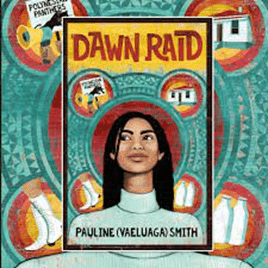BOOK REVIEW
Dawn Raid

Dawn Raid
Author: Pauline (Vaeluaga) Smith
Illustrator: Mat Hunkin
Scholastic
ISBN: 9781775434757
RRP: $19.99
Paperback
March 2018
Ages: 11-14 (year 7-9)
Themes: family, race, protest, identity, migration
Reviewer: Ellie Simatos, English and History Teacher, St Andrew’s College, Canterbury
“Imagine this: You’re having an amazing family holiday, one where everyone is there and all eighteen of you are squeezed into one house. Fast forward to 4 o’clock in the morning, and there’s banging and yelling and screaming. The police are in the house, pulling people out of bed…”
Dawn Raid introduces young readers to the New Zealand Dawn Raids in the 1970s. The story is told through diary entries narrated by Sofia Savea, a 13-year-old girl whose family becomes involved in the Dawn Raid protests with the Polynesian Panthers. Sofia initially does not understand what’s happening, and her discovery of the truth is explained to the reader in a manner that is easy for young people to understand.
Sofia’s family lives in Porirua, so this could be a great local text for students in the lower North Island. Sofia’s mother is Pākehā and her father is Samoan. There are elements of Māori culture throughout, including a discussion on the Māori Land March. The text is successful as it shows what life is like for a young girl living in a multicultural community.
Dawn Raid would be a suitable class text for a year 7-9 class. The rich historical context would allow for plenty of discussion and further research. Teachers could use this novel to explore human rights, other New Zealand protests, or study protest poetry.
As Sofia is 13, students in the 7-9 year levels will be able to connect to her, despite her story being based in the 1970s. The style of writing is typical of a girl of Sofia’s age and she often displays immaturity. At the beginning of the book her main concerns are fears over a speech at school and saving up for a pair of boots. Due to the style of writing, I would not recommend this above year 9 level, although it could suit year 10 reluctant readers.
This book is highly recommended as a method of incorporating New Zealand and Pasifika history into the English classroom.


